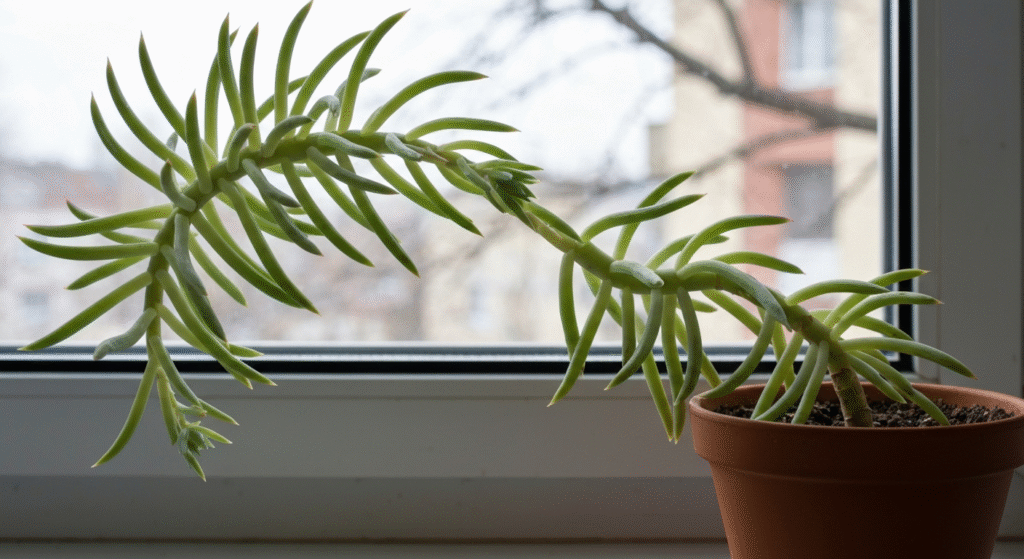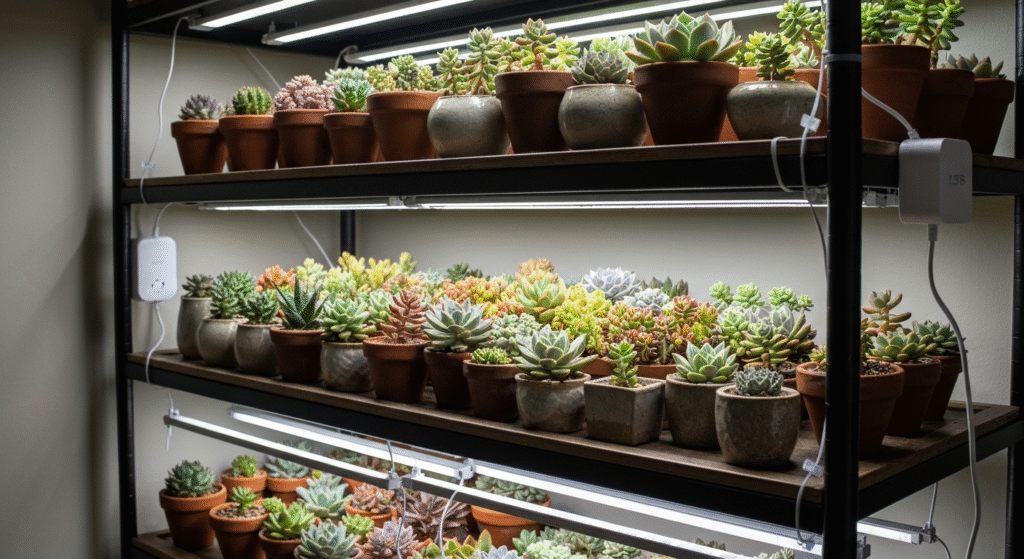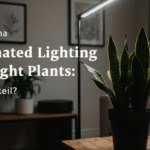We’ve all been there. You buy a stunning, vibrant Echeveria or a cute, chubby succulent, place it in your sunniest window, and feel proud. Then, a few weeks later, it starts to look… sad. It’s stretching out, turning a pale green, and leaning desperately toward the glass. That beautiful, compact rosette is now a lanky, spaced-out shadow of its former self. This stretching, called etiolation, is the number one sign your high-light succulent is starving for more sun.
Hello, I’m Priya. My journey into this world started about five years ago, born from a personal frustration: I loved my light-hungry Echeverias, but my apartment windows just weren’t cutting it. I dove head-first into the world of smart home tech, testing countless sensors and timers to figure out what actually works. After a lot of trial and error (and a few stretched-out plants), I found a system that clicks. Now, I’m passionate about sharing those practical, hands-on solutions to help you bridge the gap between technology and a thriving indoor garden.
The truth is, even the sunniest indoor spot is often a dim cave compared to a succulent’s native habitat. This is where an automated lighting schedule isn’t just a fancy add-on; it’s the single most important change you can make for your plants. Let’s walk through how to set one up, step-by-step.
Why Your Sunny Window Often Isn’t Enough

Before we get to the “how,” let’s cover the “why.” High-light succulents, like most Echeverias, Graptopetalums, Pachyphytums, and many cacti, evolved in harsh, sun-drenched environments. They expect intense, direct sunlight for most of the day.
Here’s why your indoor setup struggles to match that:
- Window Direction: Only a south-facing window (in the Northern Hemisphere) gets strong, direct light. East windows get weak morning light, and west windows get hot afternoon light, but both are often for too few hours. North windows are a no-go for these sun-lovers.
- Weather and Seasons: Winter is the worst. The days are short, and the sun’s angle is low, meaning the light intensity is much weaker. Even on a bright winter day, the total “amount” of light your plant gets is tiny.
- Obstructions: Trees, other buildings, and even the screens on your windows cut down on usable light.
- Window Glass: Modern windows often have UV coatings or glazes that filter out parts of the light spectrum, further reducing what your plant can use.
When a succulent doesn’t get enough light, it enters survival mode. It stretches, spreading its leaves out to create more surface area to “catch” any available light. It also loses its beautiful “sun stress” colors (the pinks, purples, and reds) and reverts to a basic green because it’s prioritizing survival (photosynthesis) over appearance.
What is an Automated Lighting Schedule?
An automated lighting schedule is simply a system where your grow lights turn on and off at the same time every single day, without you having to touch a switch.
This is done using a timer, which acts as the “brain,” and a quality grow light, which acts as the “sun.”
Why automation? Consistency.
I can’t tell you how many times I used to forget to turn my lights on in the morning or, just as bad, forget to turn them off at night. Plants thrive on routine. An erratic schedule—8 hours one day, 16 the next, and 4 the day after—stresses them out. Automation removes the single biggest point of failure: human error. It provides your plants with a reliable, consistent “day” they can depend on, every single day.
Picking the Right Tools for the Job
You only need two things: the right lights and a way to automate them. But the details matter. After building several setups, I’ve learned to be picky about both.
First, the Lights (What Actually Matters)
The grow light market is confusing. You’ll see terms like “watts,” “lumens,” and “kelvin.” While these give you clues, the only metric that really matters to your plant is PPFD (Photosynthetic Photon Flux Density).
- What it is: PPFD measures the actual amount of usable light particles (photons) that hit a specific spot on your plant each second.
- Why it matters: This is the true measure of a light’s power from your plant’s perspective.
- What to aim for: For high-light succulents, you want a strong “sun.” I aim for a PPFD reading of 200 to 400 µmol/m²/s at the level of the plant’s top leaves.
You don’t need to buy a $200 PAR meter to measure this. Reputable grow light brands (like Barrina, Mars Hydro, or Sansi) will often provide a PPFD chart in their product listings. Look at the chart and see what the PPFD is at a distance of, say, 6-12 inches.
Here are the types of lights I’ve found work best for different setups:
- Full-Spectrum LED Bulbs (E26/E27): These screw into any standard lamp. They are perfect for a single, large specimen plant or a small cluster of pots. I use Sansi LED bulbs in clamp lamps for my isolated plants.
- T5 or T8 LED Light Bars: These are my absolute favorite for shelves. They are thin, linkable, and provide amazing, even coverage across a whole shelf. Most of my collection lives under T5 bars.
- LED Panels: These are powerful, square-shaped panels. They are great for a larger, open table of succulents but can be overkill (and too hot) for a tight shelving unit.
A note on “blurple” lights: Avoid those pink/purple LED lights if you can. While plants can use that light, full-spectrum white LEDs are far superior. They let you see your plant’s true colors (so you can spot problems like pests or rot) and are just much more pleasant to live with.
Second, the “Brain” (Timers vs. Smart Plugs)
Once you have your lights, you need to automate them. You have a few options, but for me, one is the clear winner.
- Simple Mechanical Timers: These are the old-school beige boxes with pins you push in. They work, they’re cheap, and they are tough. But they are noisy (that constant whirring), a pain to reset if the power goes out, and you can only set one on/off schedule.
- Digital Outlet Timers: These are a step up. They’re quiet and can often store multiple schedules. However, I’ve found their tiny buttons and confusing interfaces make them a real chore to program.
- Smart Plugs: This is the heart of my smart-gardening setup. A smart plug (from brands like Kasa/TP-Link, Wyze, or Govee) connects to your Wi-Fi and is controlled by an app on your phone.
Here’s a quick comparison based on my experience using all three.
Timer Showdown: Why I Went “Smart”
| Feature | Simple Mechanical Timer | Digital Timer | Smart Plug |
| Ease of Setup | Easy, but clunky. | Difficult. Tiny buttons and menus. | Very Easy. A phone app guides you. |
| Schedule Flex | Low. Usually one on/off cycle. | Medium. Can set 7-day schedules. | High. Unlimited schedules, “away” mode. |
| Remote Control | None. | None. | Yes. Turn on/off from anywhere. |
| My Experience | The clicking sound drove me nuts. | I lost the manual and couldn’t change the time. | I named mine “Succulent Shelf.” Easy to edit. |
| Grouping | No. | No. | Yes. I can group 4 plugs into one “room.” |
| Cost | $ | $$ | $$ |
For me, the smart plug is the clear winner. The ability to pull out my phone, tap an app, and adjust the schedule for my “Succulent Shelf” group in 10 seconds is a game-changer. It also makes it easy to add other devices, like a small fan for air circulation, to the same schedule.
Creating Your Succulent’s Perfect “Day”
You have your lights and your timer. Now, let’s program the schedule. This is where I see most new growers make one of two mistakes: too little light or too much, too fast.
The Big Question: How Many Hours?
For high-light succulents, you need to provide both intensity (strong PPFD) and duration (enough hours).
- The Baseline: A great starting point for high-light succulents is 12 to 14 hours per day.
- My Sweet Spot: I run my main shelves for 14 hours on the dot. My lights turn on at 7 AM and off at 9 PM. This schedule has completely stopped etiolation and brought out deep-sun stress colors in my Echeverias.
- Can You Do 16+ Hours? You can, but you may not need to if your light is strong enough. More hours with a weak light can be just as good as fewer hours with a strong light. The total light “volume” is what matters. This is known as the Daily Light Integral (DLI). You can learn more about the science of DLI from horticulture experts, like this fact sheet on indoor succulents from Clemson University.
- Why Not 24/7? Never run your lights 24/7. Succulents, like most plants, have metabolic processes (CAM photosynthesis) that require a dark period. They “breathe” at night. A 24-hour “day” will stress them, disrupt their cycles, and can lead to poor health. They need 8-10 hours of darkness.
The Secret: Acclimating Your Plants
This is the most important step. Do not take a succulent that was stretching in a dim window and immediately blast it with 14 hours of high-intensity light 6 inches away. You will burn it.
Plants, like people, get sunburned. You’ll see ugly brown or white bleached-out patches on the leaves. This damage is permanent.
You must acclimate them slowly. Here is the exact process I follow:
- Start High: When you first install your lights, hang them 18-24 inches above the plants.
- Start Short: Set your new automated schedule to only 8 hours per day.
- Watch and Wait: Let this run for 3-4 days. Watch the plants. They should be fine.
- Increase Duration: After 3-4 days, increase the schedule to 10 hours.
- Wait Again: Let this run for another 3-4 days.
- Increase Duration Again: Bump the schedule up to 12 hours. Run this for a full week.
- Lower the Light: If the plants show no signs of burning, lower the light fixture by a few inches (to 12-15 inches).
- Finalize: Go to your final 14-hour schedule. Watch closely for one more week. If all looks good, you are set.
This slow, patient process allows the plant to build up its “sunscreen” (protective pigments) and adapt to the new, powerful light source without stress or damage.
My Step-by-Step Setup: A Look at My Smart Succulent Shelf

To make this real, here is the exact process I used for my main IKEA shelf.
- Assessed the Space: I have an IKEA “Vittsjö” shelf. The shelves are long and narrow, made of glass.
- Chose the Lights: This shelf size was perfect for T5-style LED light bars. I bought a pack of 4 linkable, 2-foot-long, full-spectrum LED bars.
- Mounted the Lights: I used heavy-duty, clear zip ties to attach two light bars to the underside of the metal shelf above my plants. The bars are spaced about 4 inches apart to give even coverage.
- Connected the “Brain”: All the lights’ power cords plug into one power strip. That single power strip is then plugged into one Kasa Smart Plug.
- Set the Schedule:
- I opened the Kasa app on my phone.
- I added the new plug and named it “Main Succulent Shelf.”
- I tapped “Schedule” and created an “On” event for 7:00 AM, set to repeat every day.
- I created an “Off” event for 9:00 PM, set to repeat every day.
That’s it. The entire setup took about 30 minutes. Now, for months on end, that shelf runs itself. The only thing I have to do is water the plants (and admire them, of course).
How to “Read” Your Succulents: Is It Working?
Your plants will give you clear feedback. Here’s what to look for.
The Good Signs (What You Want to See)
- Compact Growth: New leaves will grow in a tight, dense rosette. The space between leaves (the internodes) will be very short.
- Vibrant Colors: After a few weeks, you’ll see those “sun stress” colors come back. Pinks, purples, reds, and bright-yellow edges will start to appear.
- “Farina” Production: Many succulents produce a white, powdery coating called farina. This is a natural sunscreen. A healthy plant under good light will have a thick, undisturbed layer.
- Flowering: Happy, mature plants will often send up flower stalks.
Troubleshooting Guide: Common Problems & Fixes
After five years, I’ve run into most of these problems. This table is basically my mental checklist for when a plant looks “off.”
| Problem | Likely Cause(s) | My Go-To Solution |
| Plants are still stretching (etiolating). | 1. Light duration is too short. 2. Light is too far away. 3. Light is not strong enough (low PPFD). | 1. Increase schedule from 12 to 14 hours. 2. Lower the light fixture by 2-3 inches. 3. If 1 & 2 fail, you may need a stronger light. |
| Brown, white, or “crispy” spots on top leaves. | 1. Light is too close. 2. You “cooked” it (acclimated too fast). | 1. Immediately move the light fixture up 4-6 inches. 2. The burned spots won’t heal, but new growth will be fine. |
| Leaves are curling down strongly. | This is often a sign of too much light. The plant is trying to reduce its exposed surface area. | 1. Raise the light 2-3 inches. 2. Or, reduce the schedule by 1 hour (e.g., from 14 to 13). |
| Bright green algae growing on the topsoil. | Light is good! But… you have too much moisture and not enough airflow. | 1. Water less often (let soil dry 100%). 2. Add a small smart fan to the same schedule. |
| Plants look fine, but no stress colors. | The plant is healthy, but not “stressed” enough. It has enough light to live, but not to blush. | This is optional! But if you want colors, slowly increase light intensity (move light 1 inch closer) or add an hour. |
Frequently Asked Questions (FAQ)
Q: Can I just leave my grow lights on 24/7?
No, please don’t. Succulents need a dark period to “breathe” and carry out their metabolic cycles (CAM photosynthesis). A 24/7 light schedule will stress the plant and lead to poor health. Always provide at least 8 hours of darkness.
Q: How close should the grow light be to my succulents?
This depends entirely on the strength (PPFD) of your light. As a general rule, most LED bars (like T5s) should be 6 to 12 inches from the top of the plants. Powerful LED bulbs may need to be 12-18 inches away. The best way to know is to follow my acclimation process and watch for signs of burning (too close) or stretching (too far).
Q: Do my succulents need a “rest” day from the light?
No. They need a rest night (the dark period), but their “day” should happen every single day. Consistency is the goal. In their native habitat, the sun rises every day; your grow lights should, too.
Q: Will an automated schedule make my electric bill skyrocket?
This was a big worry for me, too! But the answer is almost certainly no. Modern LED grow lights are incredibly energy-efficient. A typical 2-foot T5 LED bar uses only 20-30 watts. Running that for 14 hours a day costs pennies. My entire multi-shelf setup costs less than a few dollars a month to run.
Your Succulents Will Thank You
Setting up an automated lighting schedule is the single biggest “level-up” moment for an indoor succulent grower. It takes the guesswork, stress, and human error out of the equation. It’s the most reliable way to give your sun-loving plants the one thing they crave most.
By picking a quality full-spectrum light and pairing it with a simple smart plug, you are creating a perfect, consistent “sun” that will stop stretching, bring out vibrant colors, and finally let your succulents thrive indoors. Your plants will be happier, and you’ll get to enjoy them without the daily “did I turn on the lights?” panic.


